Understanding GeoLink Solutions and RTK: The technology behind Toro’s new autonomous mowers
When we revealed Toro’s new autonomous solutions at BTME earlier this year, the turfcare sector was abuzz with interest. Questions about the technology, its suitability for different golf courses and sports turf, and how it will change the industry came thick and fast.
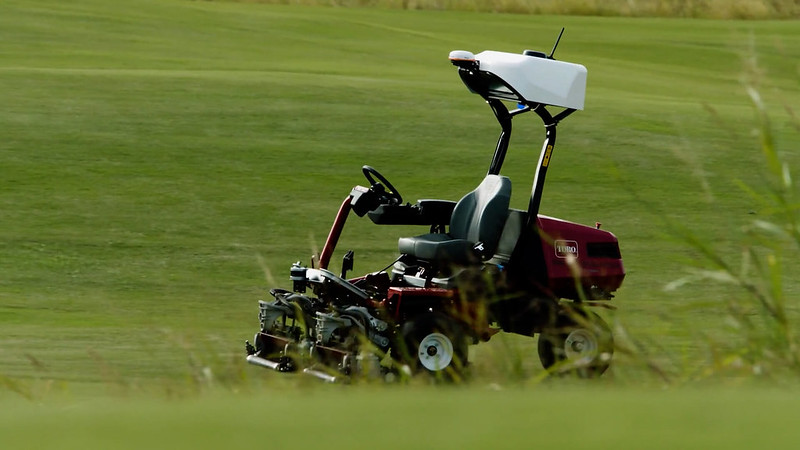
As part of my role as GeoLink and Digital Specialist at Reesink Turfcare, the UK’s exclusive distributor for Toro, I’m here to support our customers, helping them understand how the new technology works, what benefits it can offer, and what’s required.
In this article, I’ll go over the new range, spotlighting each new product individually, before providing a detailed explanation of how Toro’s proprietary GeoLink Solutions technology works with RTK (Real Time Kinematic) positioning to deliver autonomous turfcare that’s accurate to 2cm.
Autonomous turfcare systems: a new generation of Toro technology
Toro has kicked off 2025 with three new autonomous machines. Each one forms part of this exciting, new generation of turfcare technology that’s got the whole industry talking.
GeoLink Solutions Autonomous Fairway Mower
First, there’s the flagship GeoLink Solutions Autonomous Fairway Mower, the result of many years of research and development.
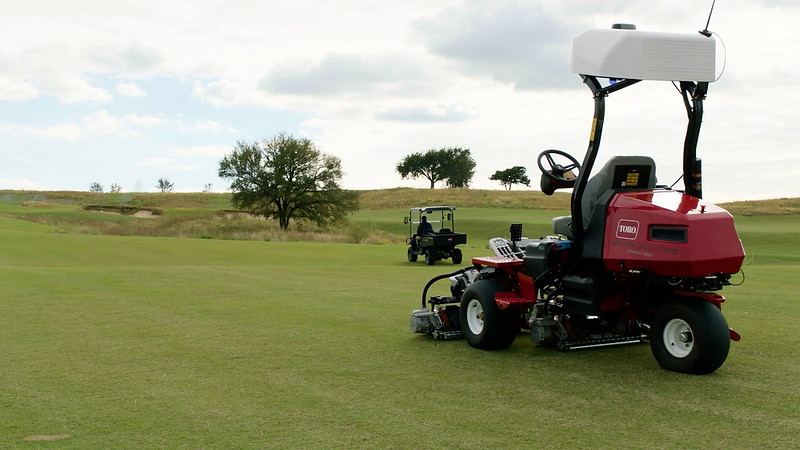
A hybrid-powered mower, it delivers the quality of cut and high-end performance that Toro is known for – either with an operator or completely autonomously, thanks to a combination of Toro’s GeoLink, NTRIP (Networked Transport of RTCM via Internet Protocol), and RTK positioning. Here are some of the highlights:
- Autonomous path planning with automatic turns
- Obstacle detection for safe, uninterrupted operation
- Optimised overlap for efficient, uniform coverage
- Maintains perfectly straight mowing lines
- Fitted with a fairway EdgeMax bedknife (HOC range: 9.5–25.4mm)
- Eight-blade cutting units specifically designed for fairways
- Off-greens kit included for smooth finish at higher cutting heights
The machine has already proved itself in a real-world setting, having been tested at The Old Collier Golf Club in Naples, Florida and other courses over the last year. We can’t wait to see this technology in action across the UK.
Turf Pro and Range Pro
Next up is Toro’s new range of robotic mowers, currently consisting of: the Turf Pro 300/500 Series robot mowers, which work at height of cut ranges between 15mm and 100mm, making them perfect for fairways, roughs, and sports pitches; and the Range Pro 100 Series ball picker, which can collect up to 19,500 balls in 24 hours.
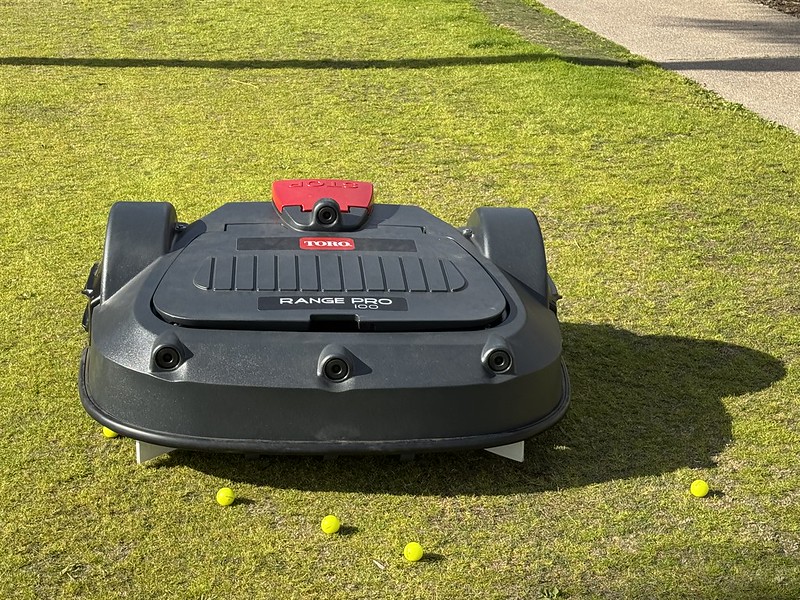
All are electric-powered and use GPS and RTK positioning data instead of underground wires. Once programmed, they require limited human intervention, offering golf clubs and driving ranges accurate mowing and ball picking wherever and whenever they need it.
Here are the topline stats for the Turf Pro range that you need to know:
Toro’s Turf Pro range:
- Mows up to 18.5 acres (75,000m²) per charge
- Fully electric, self-charging, and automatically returns to its charging station
- Achieves a full charge in just 90 minutes
- Navigates to 0.75–1.25ins (2–3cm) level precision
- Delivers consistent mowing patterns with minimal overlap
- Monitor and control wirelessly via computer or mobile device
- Choose from three or five cutting heads:
- Turf Pro 300: 63.3cm (25ins) cutting width
- Turf Pro 500/s: 103.3cm (40.7ins) cutting width
- Turf Pro 500S model handles 24 degrees of slope
A powerful piece of technology to boost productivity and reduce costs
All of Toro’s new autonomous solutions have been developed to boost productivity and consistency of cut – helping teams do more with less. These machines address labour shortage concerns by freeing up more time for greenkeeping teams and reducing operational demands and costs.
Plus, in many cases, autonomous mowing can be up to two-thirds cheaper than traditional machines, especially when factoring in reduced labour requirements and fuel savings. Let’s take a look at the new technology that powers these impressive savings.
Toro’s precision technology: GeoLink, NTRIP, and RTK explained
There are a few different technologies used across Toro’s new autonomous range, so it’s worth taking a moment to explain how each one works. Let’s start with GeoLink.
GeoLink
GeoLink is, as its name suggests, the technology behind the GeoLink Solutions Autonomous Fairway Mower. If you’ve used Toro machinery before, you might be familiar with the term GeoLink; it’s used on Toro’s Multi Pro machines to deliver pinpoint spraying accuracy.
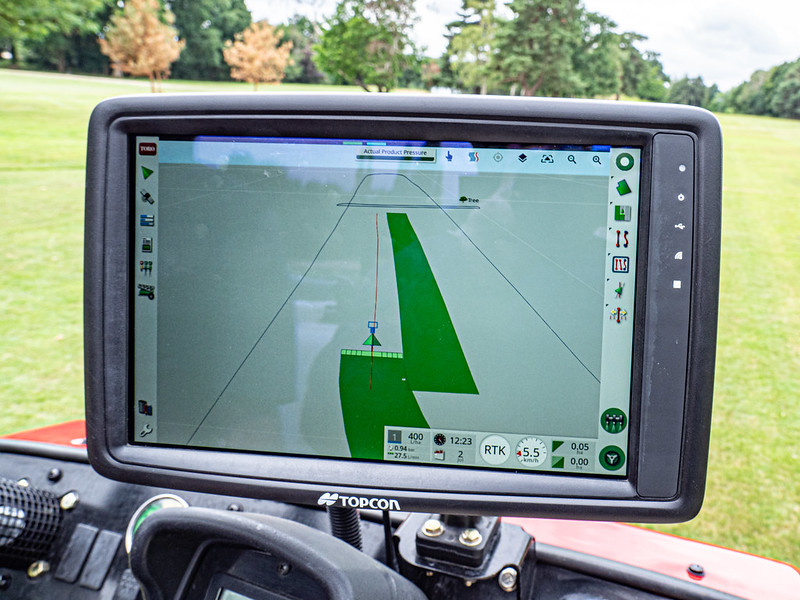
Following its success with the Multi Pro, Toro has applied the same technology to a fairway mower. By integrating geospatial data with a mix of proprietary and third-party communication technologies, the machine benefits from real-time tracking and geographic information analysis, delivering an accuracy of 2cm.
How does GeoLink work?
Toro’s GeoLink integrates geospatial data with communication technologies to enable location-based services, real-time tracking, and geographic information analysis.
It works by connecting to a national reference station network. Once connected, machines can navigate with pinpoint accuracy (2cm), executing flawless mowing patterns – all without manual input.
One of the best things about GeoLink, aside from its accuracy, is that it has been designed specifically for turf professionals, making the technology not only powerful but practical, easy to use, and ideal for real-world golf course conditions and terrain.
NTRIP (Networked Transport of RTCM via Internet Protocol)
GeoLink works in tandem with NTRIP, another clever piece of technology that connects mowers to the internet to provide additional correction data. By tapping into a national network, NTRIP maintains a high level of precision even across large or challenging landscapes.
When combined, these technologies allow the mower to work out its mowing and charging time, and then map the most efficient route to complete its job. However, this will require human verification, so it’s about working with these new machines and coming up with a strategy to get the most out of them.
RTK (Real Time Kinematic)
These technologies work with RTK satellite positioning. RTK uses a localised connection to improve standard GPS data. Let’s break down how:
- GPS provides a rough location estimate
- RTK corrects that signal using a fixed reference point – in this case a mast, which is placed in an open air location with a clear sky view
- An antenna module (rover) inside the mower will then start talking to the mast
- The mower sends a signal to the mast; the time it takes for that signal to be received by the mast allows the system to calculate its exact position in real time
- The longer it takes for the signal to be received, the further away the rover is from the mast
In short, RTK serves to calculate and send real-time correction signals to the mower, enhancing the precision of the machine’s position.
What positioning technology does the Turf Pro and Range Pro use?
The Turf Pro and Range Pro models use a combination of GPS and RTK technology, which allows them to perform automated tasks with a strong degree of accuracy, typically within a few centimetres. Because these systems are satellite-driven, there’s no need for boundary wires, which makes the setup quicker, adjustments easier, and the system far more flexible.
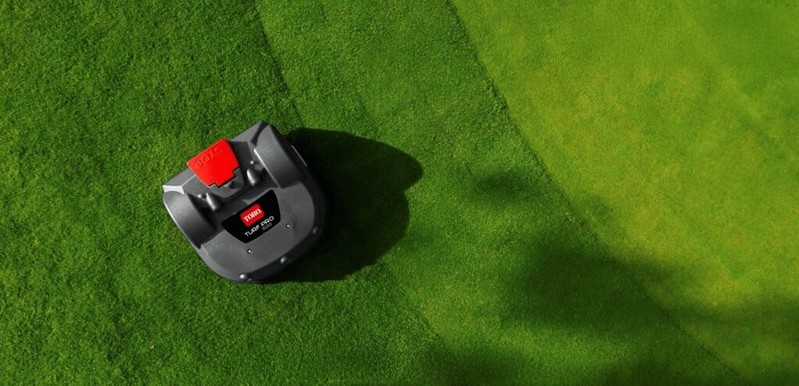
These machines aren’t designed to make complex decisions, and certain terrain features like raised manhole covers, uneven irrigation heads, or steep slopes can pose challenges. Understanding these limitations is key to help operators plan routes and site layouts for optimal performance and minimal disruption.
Making the transition to autonomous – we’re here to help with training and support
Introducing autonomous mowing into your operations is a shift, but one we support every step of the way. At Reesink Turfcare, it’s my job to make sure our customers receive thorough in-person training on how to use, maintain, and get the most out of their new equipment.
Autonomous systems require thoughtful planning. For example, the Turf Pro robot mowers work in a cycle of around 200 minutes: 110 minutes of cutting followed by 90 minutes of charging. That means you’ll need power stations positioned strategically around your course.
Although laying cables and installing chargers might feel like an additional expense, it’s a long-term infrastructure upgrade that supports not only today’s machines, but the next generation.
Just like the infrastructure considerations that have had to be made for hybrid and electric machinery charging, tweaking the workshop and methods of working for autonomous technology will soon be just as understood and straight-forward. Once set up, even if the products change in years to come, you’ll still have the necessary infrastructure to run them.
Site surveys and inspections to assess suitability
We also carry out detailed site surveys, combining satellite mapping and physical inspections, to determine whether a site is suitable. Not all courses or grounds will be suitable from day one, but many courses can be adapted with the right planning.
During an inspection, we’ll look at the terrain, identify obstacles like manhole covers and irrigation heads, and assess signal strength for GeoLink. We recommend that clubs nominate a resident expert, who we will train on autonomous technology, giving them the skills they need to manage the machines at that venue.
The role of autonomous machinery in the future of turfcare
Toro’s autonomous range is already making waves, but it’s just the beginning. There will always be a need for traditional mowers, either due to terrain, location, or preference, and as we see now with hybrid and electric machines comfortably running alongside diesel, there’s always room for different technologies.
The current technology doesn’t cut greens or tees – just fairways. In the coming years, I think we’ll see autonomous machines delivering a finer cut, giving greenkeepers even more flexibility when it comes to turf management.
It’s important to point out that autonomous technology won’t replace turf teams – far from it. Rather, it’s about giving staff the freedom to focus on the work that requires human skill and expertise, while letting these machines handle more repetitive tasks efficiently and consistently. This has the potential to not only improve overall productivity but also boost staff morale, as they spend less time on routine mowing and more time on higher-value tasks that make use of their experience and judgement.
Contact us today to learn about Toro’s autonomous solutions
GeoLink and RTK will become part of the foundations of Toro’s autonomous future, combining proven navigation accuracy with user-friendly design – and all backed by the strength of the Toro brand and Reesink’s unrivalled support network.
For any clubs or turf managers unsure about adding this new way of working to their fleet, we’re here to help – with transparent advice, site surveys, and training to support your decision-making.
If you’re curious about what it could mean for your course or sports club, contact Reesink Turfcare by calling 01480 226800, emailing info@reesinkturfcare.co.uk or visiting reesinkturfcare.co.uk.
